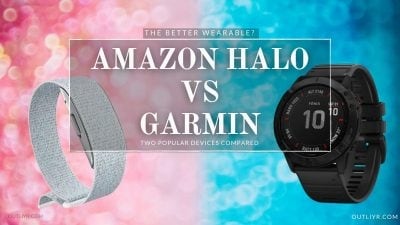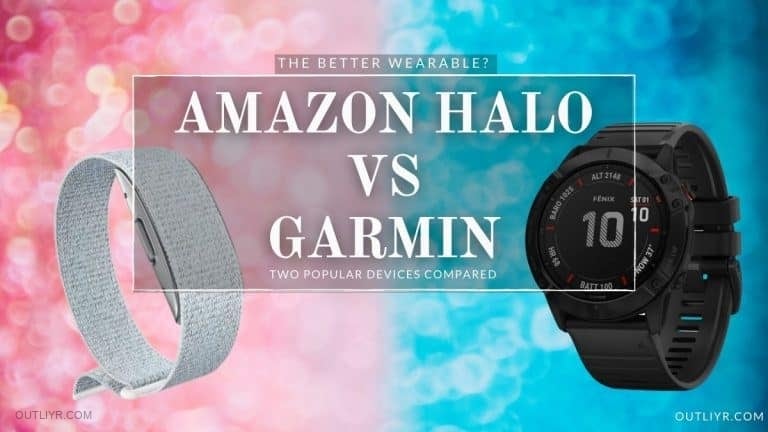I can’t remember how I came across it.
Likely through word-of-mouth, but maybe podcasts, videos, or online product reviews.
In the fitness community, Garmin has a long history of effective wearables.
Their two most popular lines are the Vivoactive and Fenix.
I bought an Oura Ring years ago and have worn it religiously. Oura’s among the only accurate and multi-purpose wearables on the market. But there are other popular alternatives:
- Oura Ring (see my Oura vs Amazon Halo review)
- Apple Watch
- Biostrap
- WHOOP
- Garmin
However, Oura is mediocre for workout tracking and must be removed whenever using barbells or dumbbells.
I bit the bullet and scored a Garmin Fenix watch to track my training.
Though my Garmin has lasted and performed well, rumors claimed that a new smart device market would dethrone it as the best fitness wearable.
Today I will compare my Garmin Fenix to the Amazon Halo. I’ll break down the pros and cons of each, and help you decide if you should go for Amazon’s latest device.
Halo vs. Garmin: Initial Impressions
My Halo came in standard small Amazon envelope.
Inside, however, came a rather sleek box. Almost like unwrapping the latest iPhone.
Immediately, I had an instructional email waiting in my inbox:

Unlike most instruction pamphlets that I throw away without opening, the email was concise and crafted with care.
The first thing that struck me was the Halo’s weight (or lack thereof). Compared to my big and bulky Garmin, the Halo felt like a bracelet.
If you’re looking for a screen or a watch that tells time, skip the Amazon Halo.
Progressing through the app’s setup went seemlessly. Within 5 minutes of beginning the unboxing process, I got back to my previous task. Double-tapping the device’s only button syncs it to your phone and populates the app’s dashboard with your personal data:
- Step count
- Total calories
- Activity points
- Activity intensity
- Activity log
- Max heart rate
- Resting heart rate
- Live heart rate
I always customize my wearables to the fullest extent. The Halo, however, has few tweakable settings. My primary concern (and ultimately dealbreaker) is its lack of airplane mode. On my other devices, airplane mode increases battery between 2-5 fold and protects against damaging nn-EMF.
Halo vs. Garmin: Price
Garmin and Halo have completely different pricing models.
The better deal depends on your planned use:
- Short Term: Amazon Halo
- Long Term: Garmin
Garmin smart watches range from $250 to $750. They’re marketed to competitive fitness enthusiasts. It’s a one time cost, with the common models falling around $300-400.
Halo, on the other-hand, has a cheaper up-front cost of $100. You receive a free six-month subscription, and afterwards pay $4 per month.
Assuming Amazon keeps its membership fees consistent (unlikely), after about four years Garmin becomes the cheaper option.
Winner: Halo (short-term), Garmin (long-term)
Halo vs. Garmin: Battery Life
I ditched my Apple Watch because I couldn’t stand tethering myself to the charger on a daily basis. You must remove the device while charging, and thus lose precious data.
The two components of battery life that I care about include:
- Charge time
- Battery drain speed (most important)
The less you’re charging, the more data you collect.
My actual charge speeds of the two:
- Halo: 90-minutes to full charge
- Garmin: 120-minutes to full charge
Both use proprietary charging adapters.
I’ve experienced first hand that advertised and actual battery life don’t always coincide.
Such is the case with both devices.
The way you use them makes all the difference:
- Halo battery life: 48-168 hours
- Garmin battery life: 24-216 hours
Two features account for the tremendous variability
As you’ll read below, Halo’s voice analysis feature fully drains the battery in just two days.
Garmin’s biggest battery killer, however, is GPS (which Halo doesn’t have). The watch lasts up to 24 hours in GPS mode, but up to 75 hours in UltraTrac (GPS battery-saver) mode.
Winner: Garmin
Halo vs. Garmin: Fitness & Activity Tracking
Since their inception, most smart wearables have prioritized activity tracking.
For good reason.
Movement is a pillar of health.
Quantifying your fitness is straightforward.
In terms of fitness tracking, the winner is clear:
Garmin offers extensive customization, activity-specific modes, and data points to measure in real-time:
- Heart rates
- HR zone
- Timings
- Distances
- Complete maps
- Calories burned
- Speed
- Steps
- Cadence
Halo, since it’s missing a screen, tracks only the very basics:
- Step count
- Heart rate
- Points
Since the latter doesn’t show real-time data, their algorithm is built around an alternative to calories called “points” (basically M.E.T.s). Amazon takes a unique approach to scoring your fitness:
- Sedentary time (over 8 hours): -1 pt per hour
- Light activity: 1 pt per 20 mins
- Moderate activity: 1 pt per 1 minute
- Intense activity: 2 pts per 1 minute
You can find calorie burning information if you scroll through the app, but they’re clearly emphasizing the point system.
Garmin shows you all the data and leaves interpretation to you. Its screen makes the device useful without lugging your phone with you.
But here’s a little secret: today’s top sports scientists are focusing elsewhere. In fact, some ignore fitness metrics.
Winner: Garmin
Halo vs. Garmin: Heart Rate, HRV & Recovery
Fitness and health go together.
Until recently, rest and recovery have taken a back seat.
Fitness and wellness progress don’t come in the gym (or on the trail). Rather, they result from downtime. The time when the body naturally regenerates. Elite athletes and their trainers have known this for a decade. They watch recovery metrics with an eagle eye.
What happens when you crush workouts but under-recover? Your nervous system crashes and you:
- Burn precious muscle for fuel
- Store more calories as fat
- Get sick more often
- Struggle with mood
- Feel drained
One such metric is called heart rate variability (HRV) and it measures the strain on your nervous system. There are decades of research on it, and special devices that track HRV throughout the day.
Today’s top wearables all track HRV natively.
Outside of sleep, Amazon Halo does not quantify any form of recovery. Garmin, however, has free third-party apps that can measure HRV on-demand.
Additionally, Garmin watches ship with a “stress score”. A score that’s generated from HRV. If you care about recovery, Halo won’t cut it.
Winner: Garmin
Halo vs. Garmin: Sleep
I already sleep wearing the best-in-class Oura Ring.
For $65 worth of sensors, I didn’t expect much. Halo’s sleep measures:
- Time asleep
- Time to fall asleep
- Time awake
- Time in bed
- REM sleep
- Light sleep
- Deep sleep
- Disturbance count
- Sleep efficiency
- Sleep temperature
Clearly they took a page out of the Oura playbook.
Since Halo doesn’t have an airplane mode feature, I rarely sleep with it.
When I did, however, my scores were consistently slightly below my Oura. I’ve tracked 1,000+ nights with Oura and found it to be accurate when the ring stays properly seated. Halo wasn’t close to my perceived sleep score.
Tangent aside, how do Garmin and Halo compare?
I’d give Amazon a C+ and my Garmin a D-. Garmin’s sleep tracking is mostly useless.
Winner: Halo
Halo vs. Garmin: Voice & Tone
The most noteworthy feature of the Halo is its ability to analyze your voice and tone.
Amazon claims that vocal analytics will improve your life by identifying how you sound to the outside world. Throughout the day it processes your unique voice and classifies phrases according to:
- Positivity (high or low)
- Energy (high or low)
Then the app highlights notable moments from throughout the day. It identifies the predominant emotions behind each of the moments and the time that they took place.
To my dismay, you can’t play back snippets from the conversation to see if the algorithm judged properly. They claim to not store your conversations (unless bookmarked), but I’m skeptical.
You can click the side button to force the Halo to record and bookmark specific conversations. Otherwise, it just randomly samples your voice throughout the day.
Voice analysis has great potential:
- See how you speak to different people
- Real-time feedback on your presentation rehearsals
- Compare your morning and nighttime voice
Two major downsides:
- Battery drains 70% faster with it enabled
- Privacy
Like Amazon Alexa, I shutter to think of the privacy implications. Only this is worse. Not only does Amazon get unfettered access to my conversations, but the insight into how they impact my physiology. Your voice is powerful biometric data. As a Data Scientist I’m wary of my digital fingerprint, and wouldn’t use this feature long-term.
Winner: Halo
Halo vs. Garmin: Bodyfat Tracking
I’m not a fan of weight tracking.
I’ve put on 11 pounds in a single day. And on other occasions, lost similar amounts.
Body weight fluctuates too much from day to day.
I discovered that their app uses your camera and lighting to measure body fat. How accurate could it be?
Immediately I had doubts.
Thanks to machine learning and big data, decent.
Amazon claims twice the accuracy of at-home smart scales. Comparable to the state-of-the-art:
- Bod Pod
- Dual-energy X-ray absorptiometry (DXA scan)
Maybe, if you’re extremely consistent with timing, lighting, bowel movements, water intake, etc. But I don’t buy it.
I tested after a few glasses of water and again first thing in the morning.
Low and behold, after eight hours of sleep (dehydration and fasting), my body fat measurement 2.5% more than before bed.
Over time the technology will get more accurate, but for now, it’s mostly a fun party trick.
Winner: None
Halo vs. Garmin: Recommendations
Halo generates health recommendations unlike any wearable I’ve tried. It’s the closest I’ve seen to…
Automatic health coaching.
The “labs” section of the app gives you actionable coaching on improving different health facets:
- Activity
- Sleep
- Nutrition
- Mindfulness
- Tone
From there you can filter the mini courses by specific interests, brands, duration, and type.
Getting actionable coaching is as simple as opening the app to the section in question (activity, sleep, body fat, etc), and scrolling down to the relevant courses.
You can establish your baseline, learn through a rich course library, and track your progress all from the same app.
Winner: Halo
Halo vs. Garmin Smart Wearables Comparison
Both devices are well built, and track basic health data. But aside from that, they suit different personalities.
Garmin is an advanced device for those comfortable interpreting reams of granular data. It’s the ideal choice for self-optimization and athletes.
Halo is barebones with features that appeal to those looking to improve their health without complication or overwhelm. Better for entry-level users.
Below is my summary on the two devices:
| Feature | Amazon Halo | Garmin Watch |
|---|---|---|
| Screen | None | Some models |
| Price | Cheap device but requires subscription | Expensive device, no subscription |
| Maps & tracks | No | Yes |
| GPS | None | Yes |
| Body fat tracking | Yes | None |
| Tone analysis | Yes | None |
| Band material | Fabric | Silicone (other options available) |
| Battery | Mediocre | Great |
| Resources | 100+ learning & coaching programs | Blog, in-app recommendations |
| Fitness tracking | Basic | Advanced |
| HRV tracking | None | Yes (third-party apps) |
| Phone required | Yes | No |
| Social gamification | No | Yes (leaderboards) |
| Recovery tracking | Limited | Advanced |
Best Wearable: New (Amazon Halo) Versus Incumbent (Garmin)?
Amazon entered the self-quantification era with its new Halo product. It’s a lightweight, affordable, simple, feature-rich wearable better than many of the others on the market. It comes with novel abilities like voice & tone analysis and body fat analysis. Simplicity is a double-edged sword, making personal wellness data accessible to the masses, but too basic for deep health optimization. Check out my full Amazon Halo review for more information.
Serious athletes and self-optimization aficionados are better suited with Garmin watches. While not as slick, I love seeing training and recovery data on my wrist at any point — no phone required. I’m able to wander into the wilderness, relying on the watch’s GPS tracks for navigation. The initial investment is greater, but the abundance of data and free third-party apps have made the watch an integral part of my day.
Both can help you analyze and track health patterns. It comes down to this:
For another tough rivalry, see my Halo vs Oura Ring post.
Do you use either? How has your experience been?





